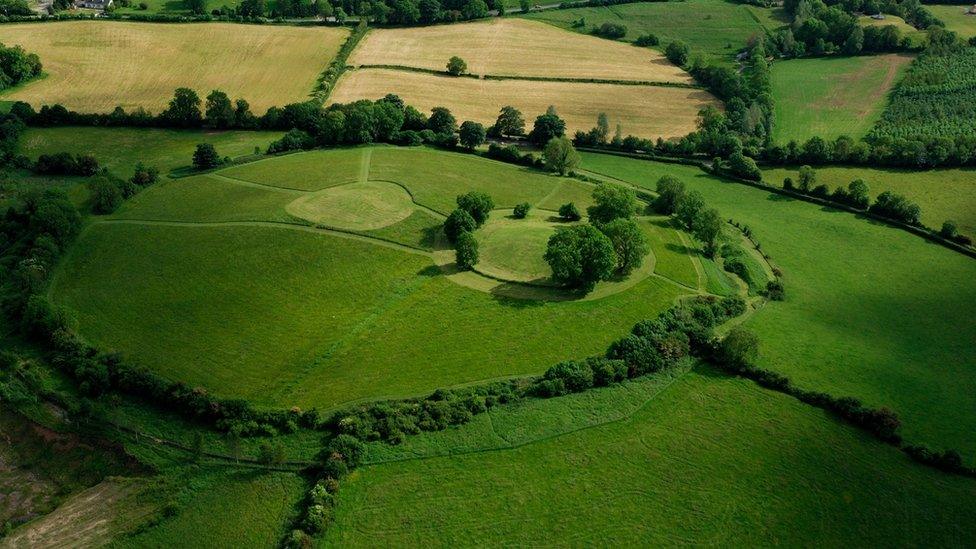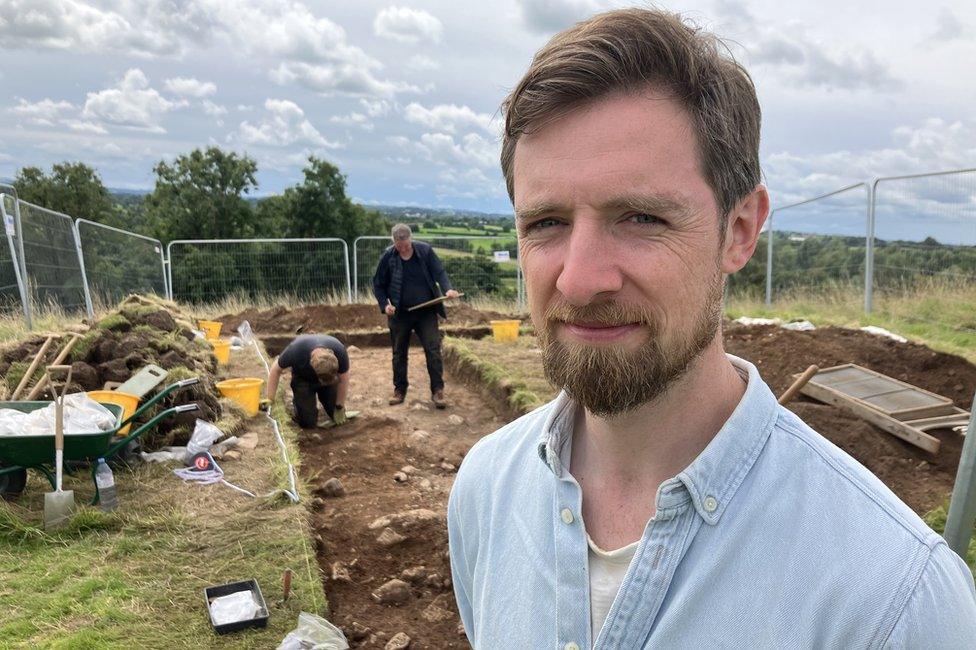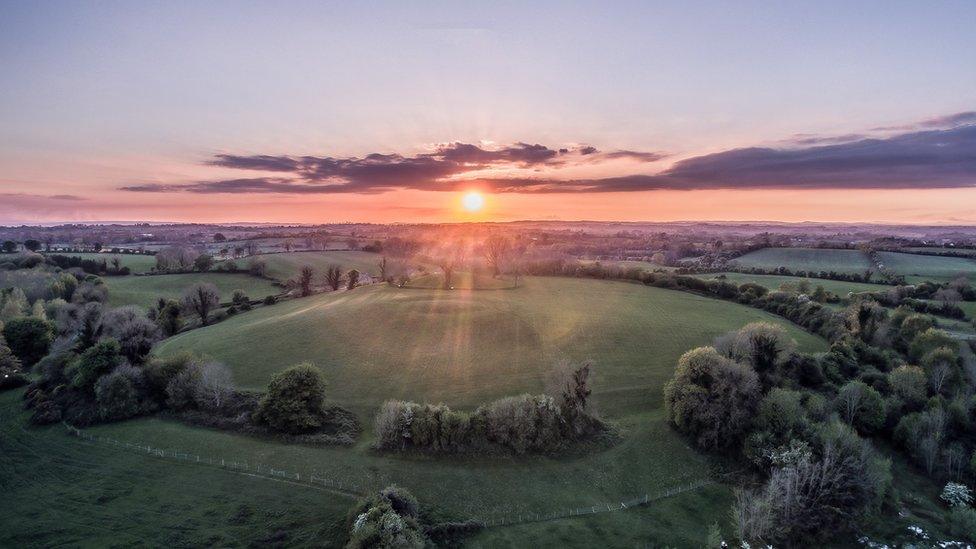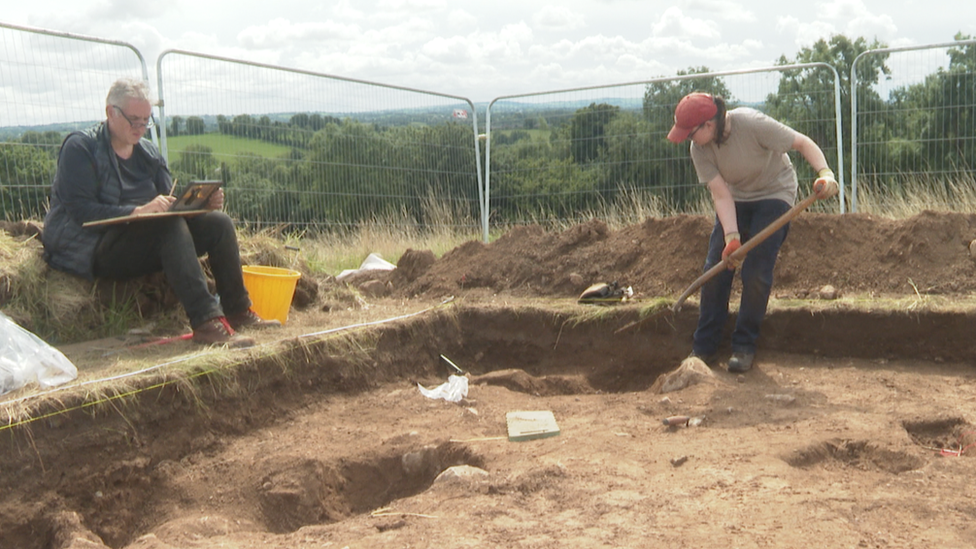Navan Fort: Dig sheds new light on home of the Kings of Ulster
- Published

Navan Fort, a large circular earthwork on top of a drumlin, was a significant religious site during the Iron Age
Perched on a hill outside Armagh city is Emain Macha - or Navan Fort.
For centuries this place was home to the kings and queens of Ulster.
In recent years archaeologists have been trying to piece together just what the complex would have looked like and how far back in history the site was in use.
They believe they have now found physical evidence that the site could have been in use as early as the 4th Century BC.
Progress took a major step forward in 2020 when magnetic gradiometry and electrical resistance surveys were conducted at the site.
This provided indications of huge Iron Age temples and other religious complexes.
This month researchers from Queen's University, Belfast returned to Navan Fort to take part in a dig, which they believe has uncovered evidence supporting this.
'Ceremonial centre'
This year's dig has seen four fresh trenches opened on the hilltop site.
"What we are discovering here is that some of the early phases here are really very special," said archaeologist Dr Patrick Gleeson.
"They are unique probably in terms of the complexity of some of these monuments on this island - there's maybe only one or two other parallels that we know of.
"Particularly because they are Iron Age in date, it is incredibly rare to find monumental structures of the Iron Age."
The Iron Age covers the period from about 800 BC to the Roman invasion of Britain in 43 AD.

Dr Patrick Gleeson is part of the research team which is trying to interpret the history of the ancient site
The findings from the dig will have to be taken away and scrutinised, but Dr Gleeson told BBC News NI he believed they are significant.
"At the moment it looks like what we have is an entirely new early to mid-Iron Age monumental horizon to the complex," he said.
"When you come to the site today everything that you see dates to around 95 BC or later.
"What we have discovered is that some of the buildings that were excavated in the 1960s sit within a huge series of timber palisaded enclosures from the 4th to 1st Century BC in terms of date range.
"They consist of large buildings on the crest of the hilltop, situated within a large figure of eight shaped enclosure about 160m in diameter stretching across the crest of the hill with huge timber posts defining the edges of the site."

Navan Fort is a part of The Royal Sites of Ireland, a group of six pre-historic sites
One of the trenches is known as site A.
"It is an enigmatic structure," said Dr Gleeson.
"It would seem to be a ring barrow but doesn't seem to be a burial monument, as we would expect a ring barrow to be.
"So we are investigating the bank and ditch of that monument. So it could have been used for production, post-medieval activity or perhaps even early medieval residential structures."
Dr Gleeson said the discovery would contribute to "our understanding of the site".
"But it also solidifies some of the suspicions that have been developing over the last number of decades that, rather than this being a residential centre of the Kings of Ulster, it actually appears to be a ceremonial centre of paramount ritual and religious significance, where people engaged in major ceremonies and activities," he added.
"Then at some point it morphs into a more residential and symbolic centre in the medieval period. That allows us to situate it, not just in an Irish context but in a north-western European context as well."
'Really exciting'
In the long term it is hoped that Navan Fort will become a World Heritage Site and it currently sits on the tentative list with five other Royal Sites of Ireland.
The significance of the project is not lost on those taking part in the dig.
PHD candidate Louise Moffett has a shovel in hand and is working as an excavator on this year's dig.
"It is really exciting," she said.
"Most of the sites I've done in the past nobody has heard of but now everybody knows the site that I've dug at."

Dr Cormac McSparron keeps drawings of the discoveries while student Louise Moffett is an excavator
"At the minute I'm excavating a feature at the back of this trench.
"We found some of the edges, so it's basically about finding those edges to work out the circumference of the feature then following them down until you find the base," she added.
"But you only half excavate it so that we have a flat surface called a section. That's how we can see if there are different layers in the feature - if it's been built up over time or if it was just a single deposit in the feature."
Perched on the side of the trench with sketchpad in hand is Dr Cormac McSparron. His drawings will later aid the development of three-dimensional models of discoveries.
"This is only a rough drawing plan done a bit below publication quality," he said.
"Just simply to note all of the numbers. It's just a quick plan that'll be added to the 3D model later."
Following completion of the dig, the trenches will be filled in.
So too, it is hoped, will gaps in our knowledge about this truly remarkable site.
Related topics
- Published22 July 2022

- Published16 July 2020
